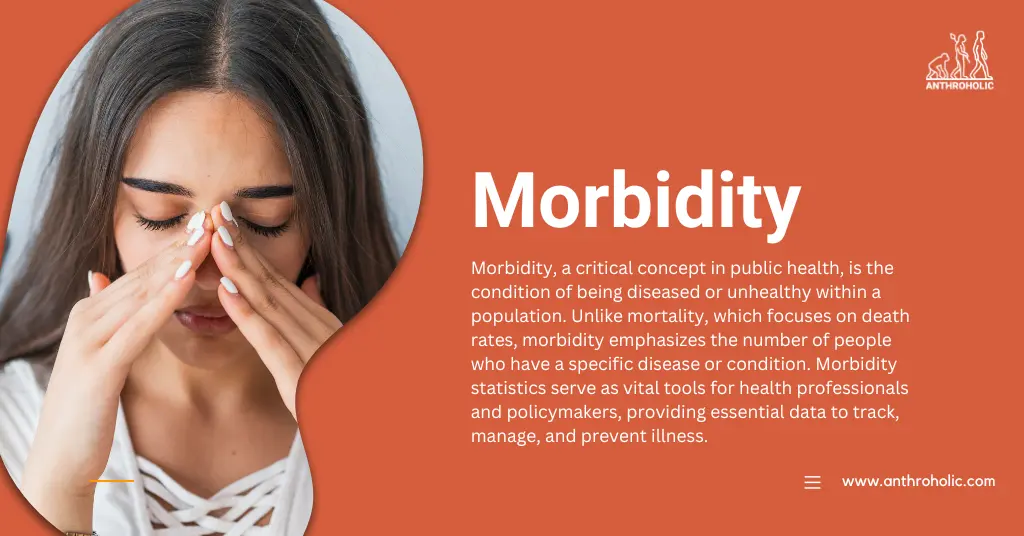AI Answer Evaluation Platform Live Now. Try Free Answer Evaluation Now
Morbidity
Morbidity, a critical concept in public health, is the condition of being diseased or unhealthy within a population. Unlike mortality, which focuses on death rates, morbidity emphasizes the number of people who have a specific disease or condition [1]. Morbidity statistics serve as vital tools for health professionals and policymakers, providing essential data to track, manage, and prevent illness.

Understanding Morbidity
Definition and Key Terms
Morbidity encompasses prevalence and incidence of disease within a population.
- Prevalence: The total number of individuals in a population with a specific disease or condition at a specific time.
- Incidence: The number of new cases of a specific disease diagnosed within a defined period [2].
Factors Influencing Morbidity
Various factors can influence morbidity rates within a population:
- Age: Certain diseases are more prevalent in specific age groups.
- Sex: Some conditions occur more frequently in one sex than the other.
- Genetics: Certain genetic traits can predispose individuals to specific diseases.
- Environment: Exposure to harmful environmental factors can increase morbidity.
- Lifestyle: Habits such as smoking, diet, and exercise significantly influence morbidity [3].
The Importance of Studying Morbidity
Studying morbidity offers several benefits:
- Identifying Disease Patterns: Helps in recognizing patterns and trends of diseases, useful in developing effective preventive measures.
- Resource Allocation: Assists in appropriately allocating healthcare resources.
- Healthcare Policy Formulation: Influences the development of effective public health policies.
- Research: Forms the basis for further medical and health research [4].
Measures of Morbidity
Morbidity Rate
Morbidity rate, often expressed per 1000 or 10,000 population, is the total number of cases of a disease in a population over a given time period [5].
| Disease | Morbidity Rate per 1000 Population |
|---|---|
| Diabetes | 30 |
| Hypertension | 40 |
| Heart Disease | 20 |
Morbidity Index
The Morbidity Index measures the intensity or severity of a disease. It accounts for the multiplicity of disease processes within an individual, offering a holistic perspective on the disease burden [6].
Morbidity Metrics in Public Health Practice
Morbidity metrics play a significant role in public health, providing a framework for assessing and addressing health concerns.
YLDs, YLLs, and DALYs
Key morbidity metrics include Years of Life Lost (YLLs), Years Lived with Disability (YLDs), and Disability-Adjusted Life Years (DALYs):
- YLLs: A measure of premature mortality within a population, computed as the number of deaths multiplied by a standard life expectancy [7].
- YLDs: A measure of the years a person lives with a disability, computed as the number of incident cases of the health condition multiplied by its disability weight [8].
- DALYs: A combined measure of YLLs and YLDs that estimates the total burden of disease, accounting for both premature death and disability [9].
Table showing an example of DALY computation:
| Health Condition | YLLs | YLDs | DALYs |
|---|---|---|---|
| Heart Disease | 5 | 10 | 15 |
| Lung Cancer | 10 | 5 | 15 |
| Diabetes | 3 | 7 | 10 |
Morbidity and Quality of Life
Morbidity not only affects life expectancy but also has a profound impact on the quality of life (QoL). Chronic conditions such as diabetes, heart disease, or cancer can result in significant disability and impact overall wellbeing. By studying morbidity, healthcare providers can better understand and manage these impacts, leading to improved QoL for patients [10].
Morbidity and Health Disparities
Understanding morbidity also sheds light on health disparities within populations. Certain groups are more susceptible to specific diseases due to various socioeconomic, genetic, and environmental factors. Health disparities reflect these differences in morbidity rates and are a major focus of public health initiatives aimed at promoting health equity [11].
Conclusion: Addressing Morbidity
Addressing morbidity is pivotal to improving public health. Preventive measures, early detection, and effective treatment are key to reducing morbidity. Moreover, through a comprehensive understanding of morbidity, health professionals, and policymakers can develop effective strategies to manage and prevent diseases within a population.
The challenge of morbidity is complex and dynamic, influenced by a myriad of factors. However, with careful analysis and proactive measures, it’s possible to significantly reduce the burden of disease and promote healthier populations.
References
[1] “Definition of Morbidity,” MedicalNewsToday, www.medicalnewstoday.com.
[2] Porta M., “A Dictionary of Epidemiology,” 5th edition, 2008.
[3] “Factors Influencing Morbidity,” WHO, www.who.int.
[4] “The Importance of Morbidity,” Public Health, www.publichealth.org.
[5] “Morbidity Rate,” CDC, www.cdc.gov.
[6] Zajacova A., Montez JK., “The Morbidity Index: An Elaboration in the Link between Education and Health,” Social Science Research, vol. 65, pp. 1–14, 2017.
[7] “YLLs – Years of Life Lost,” Institute for Health Metrics and Evaluation (IHME), www.healthdata.org.
[8] “YLDs – Years Lived with Disability,” Institute for Health Metrics and Evaluation (IHME), www.healthdata.org.
[9] “DALYs – Disability-Adjusted Life Years,” Institute for Health Metrics and Evaluation (IHME), www.healthdata.org.
[10] “Morbidity and Quality of Life,” WHO, www.who.int.
[11] “Health Disparities and Morbidity,” CDC, www.cdc.gov.




